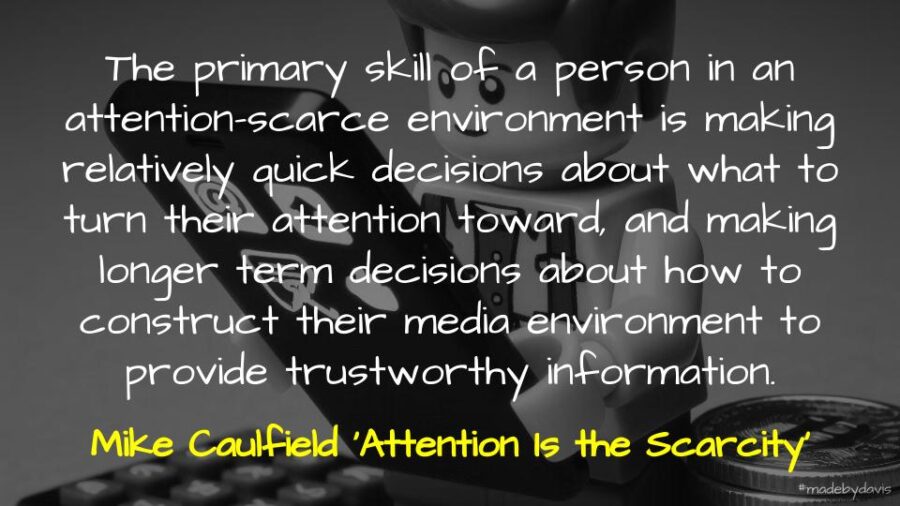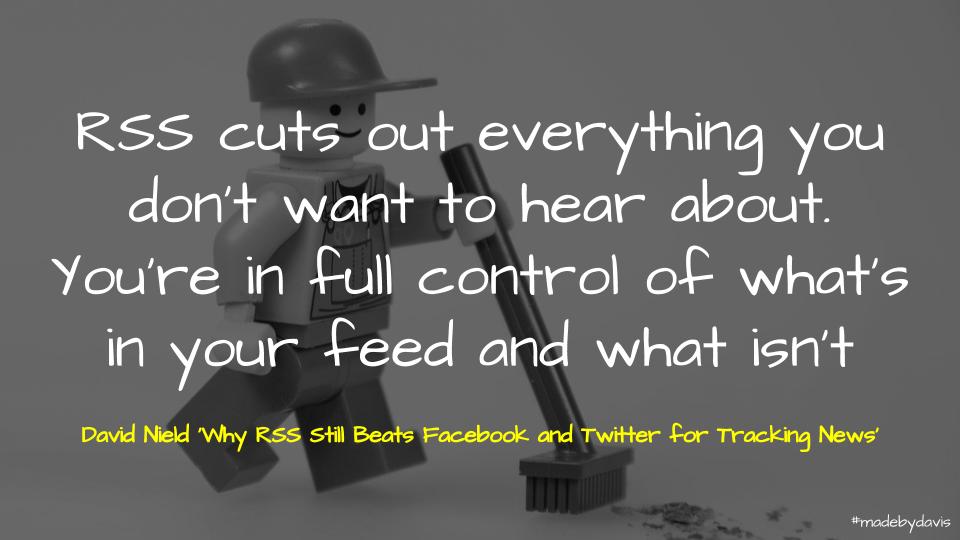Below is a collection of starts, thoughts, threads on algorithms, taste and curation. I feel that this is one of those posts that seemed less straight-forward the more I sat with it.
Losing my religion curation
Discussing Instagram’s decision to change their algorithm to field both popular and possible future popular posts in an effort to potentially fill the gap in the social media space if Tiktok is in fact banned, Mark Fennell, Alice Clarke and Angharad Yeo on Download This Show podcast rue the fact that we do not curate our feeds as we once did.
Social media platforms are like different countries and they’ve all got their own cultures.
Source: Can Instagram poach TikTok stars? by ABC Radio National
They discuss how with the algorithmically driven platforms, such as Instagram and Tiktok, we no longer have the control we once did over who and what we follow and consume, instead we have surrendered our taste and agency to somebody else.
AI and what not to read
Coming at the problem of social media, algorithms and the internet from the perspective of the creator, Douglas Rushkoff worries about the ever increasing speed and pressures placed by platforms that is creating a “perspective abundance.” He wonders if one of the challenges we face in being more “disciplined” is in fact choosing not to respond.
Most ironically, perhaps, the more content we churn out for all of these platforms, the less valuable all of our content becomes. There’s simply too much stuff. The problem isn’t information overload so much as “perspective abundance.” We may need to redefine “discipline” from the ability to write and publish something every day to the ability hold back. What if people started to produce content when they had actually something to say, rather than coming up with something to say in order to fill another slot?
Source: Breaking from the Pace of the Net by Douglas Rushkoff
To me, this touches on Dave White’s idea of “elegant lurking”
The Elegant Lurker can be much more engaged than the noisy contributor and not being visible doesn’t mean you aren’t present.
Source: Elegant Lurking by Dave White
Continuing with his reflection on the challenges of creating, Rushkoff wonders if AI actually takes the fun stuff away.
I was becoming the servant to the AI and the AI was doing the most fun part of the whole process, the actual coming up with the stuff.
Source: Breaking from the Speed of the Net by Douglas Rushkoff
This is something that Scott Stephens and Waleed Aly discuss on The Mindfield podcast, with Stephens worried about what is lost when we no longer spend the time considering what it is we are writing about.
Rushkoff then discusses the realisation that maybe the best use of AI is to use the feedback to know what not to write, to know where you have sunk into cliche:
The real value is to use what the AI produced to know how not to write.
Source: Breaking from the Speed of the Net by Douglas Rushkoff
I wonder if this logic applies to our feeds too? Whether AI recommendations are a guide of what not to read or listen to?
You are what you eat read
In a short post, Jim Nielsen reflects upon the purpose of reading, that being to expand your thinking. This thinking was in part inspired by Dave Rupert’s discussion of ideas and how we check these.
The goal of a book isn’t to get to the last page, it’s to expand your thinking.
Source: How do you verify that? by Dave Rupert
The challenge that both Nielsen and Rupert touch on is that we are not always conscious or critical of the ideas (or dots) as we consume them, even so they make us who we are. Borrowing from Ralph Waldo Emerson, Nielsen asserts the following:
I cannot remember the blog posts I’ve read any more than the meals I’ve eaten; even so, they’ve made me.
It’s a good reminder to be mindful of my content diet — you are what you eat read, even if you don’t always remember it.
Source: You Are What You Read, Even If You Don’t Always Remember It by Jim Nielsen
For me, this reminds me in part of Brian Eno’s belief that, “Beautiful things grow out of shit.”
Beautiful things grow out of shit. Nobody ever believes that. Everyone thinks that Beethoven had his string quartets completely in his head—they somehow appeared there and formed in his head—and all he had to do was write them down and they would be manifest to the world. But what I think is so interesting, and would really be a lesson that everybody should learn, is that things come out of nothing. Things evolve out of nothing. You know, the tiniest seed in the right situation turns into the most beautiful forest. And then the most promising seed in the wrong situation turns into nothing. I think this would be important for people to understand, because it gives people confidence in their own lives to know that’s how things work.
Source: Daniel Lanois & Brian Eno Here Is What Is (Youtube)
Although Eno may well be true that beauty grows out of shit, out of luck, out of chance, I imagine that there are many ugly things that also grow out of shit as well, such as weeds that grow from a single seed to also grow and strangle a forest. I wonder then if the challenge is to be curious and continually extend our serendipity surface, while at the same time being critical.
Discussing the world of information and online literacy, Mike Caulfield advocates for the importance of always checking the validity of a site. He argues that it is not enough to check what is deemed as suspicious.
One of the things I’ve been trying to convince people for the past year and a half is that the only viable literacy solution to web misinformation involves always checking any information in your stream that you find interesting, emotion-producing, or shareable. It’s not enough to check the stuff that is suspicious: if you apply your investigations selectively, you’ve already lost the battle.
Source: The “Always Check” Approach to Online Literacy by Mike Caulfield
Written before the rise of the chatbots, this is even more important these days I guess.
Mid Culture
Coming back to the Download This podcast, Fennell reflected on the way in which he feels he has surrendered his agency and taste in music to Spotify’s ‘radio’ stations and playlists. This leads to a situation of where the algorithm simply provides more of the same, but slightly different. “Only the shit you love?”
Reflecting on the growth of ‘Mid TV’, Alan Jacobs raises the wider concern about how interesting and imaginative creative work is becoming seemingly prohibited and disincentivised:
All the incentives of everyone involved are aligned against it.
Thus the thesis of this essay by James Poniewozik: “We have entered the golden age of Mid TV”:
Above all, Mid is easy. It’s not dumb easy — it shows evidence that its writers have read books. But the story beats are familiar. Plot points and themes are repeated. You don’t have to immerse yourself single-mindedly the way you might have with, say, “The Wire.” It is prestige TV that you can fold laundry to.
Or you could listen to a Sally Rooney novel on Audible while chopping the veggies. Same, basically. This is what I think about almost everything from current big-studio Hollywood movies to new literary fiction to music by Taylor Swift or Beyoncé: it’s … okay. It doesn’t offend.
Source: more rational choices by Alan Jacobs
Just as Ruskoff uses the algorithm as a guide of what not to write, it could be argued that Jacobs uses the algorithmic nature of big studios as a guide of what not to see and consume.
Source: more rational choices by Alan Jacobs
- If someone I love wants me to go to a movie with them, I do.
- Otherwise, I don’t watch movies produced and/or distributed by the big studios. (I had been leaning in this direction for a while, but I didn’t make it a guideline until three or four years ago.) I just don’t, for the same reason that I don’t read novels by people who live in Brooklyn: it’s not a good bet. The chance of encountering something excellent, or even interestingly flawed, is too remote. Not impossible — I really enjoyed Dune, for instance, and Oppenheimer, both of which I watched with my son — but remote.
Instead, Jacobs’ focus is on the human level, on personal recommendations. Again, this harks back to the importance of curation and having a network.
Coming back to music, there are different ways I feel like I am arm wrestling the mid-music algorithm. I often peruse weekly newsletters from Pitchfork, Stereogum, NPR and Double J. I enjoy diving into playlists by artists, such as Dan Snaith or Kieran Hebden, or regular curations from those like Gav R. The thing that I wonder is the way in which however I fight it, I am “always-already interpellated“, always pulled back into the ‘mid’, always within the dominant?
For example, I have recently turned to buying and listening to vinyl, one of the things that I have been left thinking is how many smaller artists actually have the money to create their music, let alone press it to vinyl, and whether that in itself serves as its own limiting factor reducing the possibility for shit to turn into gold?
Interestingly, one way I have stumbled upon new music that I have not necessarily found elsewhere is by going to concerts early and listening to the support artist. This is how I found one of my current favourites, Twinkle Digitz, when he supported Damian Cowell. Firstly, Twinkle Digitz is not on Spotify. Actually, Twinkle Digitz is not really anywhere. Feels like my version of Cowell’s ‘secret shit‘. Other than a few lockdown videos published on Facebook, I have depended upon seeing him live. I sometimes wonder if this friction of seemingly existing outside of the machine adds to the mystique? It often makes me wonder how many how many other possible Twinkle Digitz are out there, not on a playlist, playing to a small room, working a day job?
Rewilding our attention
With so many changes currently occurring around algorithms and the use of large language models at the moment, such as Google’s pivot to Generative AI in search, I am left wonder what the solution is to get beyond the ‘mid’ culture?
Here I am reminded of Clive Thompson’s call to rewild our attention.
If you want to have wilder, curiouser thoughts, you have to avoid the industrial monocropping of big-tech feeds. You want an intellectual forest, overgrown with mushrooms and towering weeds and a massive dead log where a family of raccoons has taken up residence.
Source: Rewilding Your Attention by Clive Thompson
Returning again to the discussion on Download This, one of Thompson’s suggestions is to build up your own feeds. This is something that I have discussed here:
I am not sure whether social media will go away, but with the questions being asked of it at the moment, maybe it is time for a second coming of blogs, a possible rewilding of edtech. The reality is that technology is always changing and blogging is no different. Whatever the future is, standards such as RSS and OPML will surely play their part.
Source Laying the Standards for a Blogging Renaissance by Aaron Davis
What is interesting about building your own feeds are the spaces that are interoperable, allowing you to pull content, whether it be straight out of the box or using sites like Granary, Fraidycat or RSS Anything, and those that do not, such as Twitter, Instagram and ABC Australia website.
Stephen Downes has concerns about what we mean by ‘rewilding’, arguing that it involves actively pushing beyond your usual circles.
Most people think their internet community of such-and-such is the internet community of such-and-such, especially when it contains well-read journalists, MIT fellows, and other Persons of Interest. They rarely look beyond their immediate circles of Twitter friends and news sources. Actually rewilding your attention means eschewing the popular, getting your hands dirty with real work, and reading the people nobody else reads.
Source: Rewilding Your Attention by Stephen Downes
Beyond feeds, books and searches, sites like The Forest and Tapefear add a touch of the unknown, but probably still not quite getting your hands dirty?
Coming back to Thompson’s rewilding metaphor, I wonder if the apex predator reintroduced as a part of this exercise is the question of time and productivity? Although I may curate my own feed, I often struggle to find any semblance of balance as to how I stay on top of it all? Of late, I find myself scrolling through, saving posts or podcasts for later, only for later never to arrive.
Connecting the dots, sort of
Amy Burvall once remarked that:
“In order to connect dots, one must first have the dots.”
Source: rawthought: On Ditching the (Dangerous) Dichotomy Between Content Knowledge and Creativity by Amy Burvall
For me, this post collects together a lot of dots that are floating around in my head at the moment. I have connected them, but I am not sure how well.
As always, comments welcome, especially if they can explain my current malaise to me.




